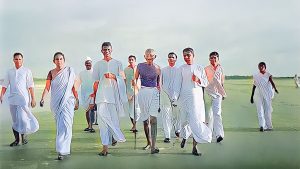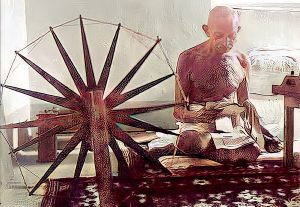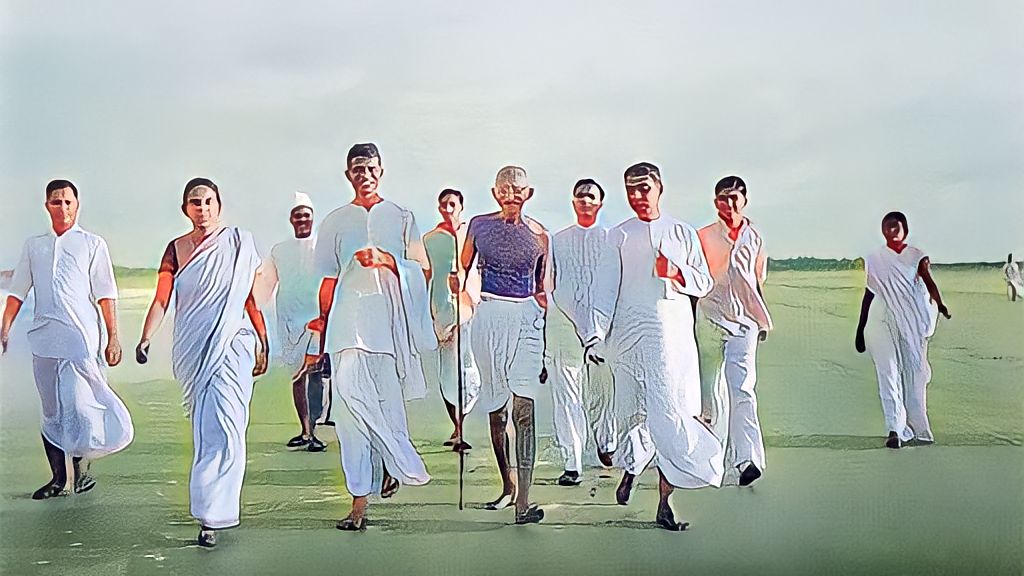Introduction to Mahatma Gandhi
Mahatma Gandhi, also known as Mohandas Karamchand Gandhi, was a political and spiritual leader in India who played a key role in the country’s independence from British rule. Born on October 2, 1869 in Porbandar, India Porbandar, India, Gandhi is remembered today as one of the greatest leaders in modern history. His philosophy of nonviolent resistance, known as satyagraha, inspired movements for civil rights and freedom across the world.
Through his tireless efforts, he fought against inequality, oppression, and injustice, and helped to bring about India’s independence in 1947. Despite his assassination in 1948, Gandhi’s legacy continues to inspire people around the world to this day. In this article, we will delve into Gandhi’s life, his political philosophy and leadership, his role in India’s freedom struggle, and the relevance of his message in the present day.
Also Read :- Sundar Pichai
Early Life and Education of Gandhi
Mahatma Gandhi, born as Mohandas Karamchand Gandhi, was born on October 2nd, 1869 in Porbandar, a coastal town in the Indian state of Gujarat. He was the youngest of his parents’ four children and was raised in a Hindu merchant family.

Gandhi’s early education was primarily in Gujarati, his mother tongue, and he received a basic education in mathematics, history, geography, and Sanskrit. At the age of 13, Gandhi was married to Kasturba, a girl his own age. After his marriage, he continued his education and completed his matriculation examination at the age of 18.
Gandhi then enrolled in a British-style high school in Rajkot, but he was not comfortable with the atmosphere and dropped out after a year. He then enrolled in Samaldas College in Bhavnagar, but again, he dropped out. Gandhi’s father passed away while he was still in school, which had a profound impact on him.
In 1888, Gandhi moved to London to study law, where he was exposed to the ideas of theosophy, vegetarianism, and the idea of Indian independence from British rule. He was also introduced to the works of Leo Tolstoy, Ruskin, and Thoreau, which shaped his political and moral views. Gandhi qualified as a barrister in 1891 and returned to India to start his law practice.
Gandhi’s early life and education had a significant impact on his later political and personal life. He learned about different cultures and religions, and developed a strong sense of compassion and justice. His experiences in England and India shaped his political and moral views, which he would later use to lead India to independence.
The Making of a Political Leader
Mahatma Gandhi, born in 1869 in Porbandar, India, was not initially known for his political activism. He was a shy and passive young man who went to England to study law, but found himself struggling to fit in. However, this changed when he was thrown off a train in South Africa for refusing to give up his first class seat to a white person. This incident marked the beginning of Gandhi’s political awakening, and set the stage for the making of a political leader.
Also Read :- Xiaomi Unveils MIUI 14 Global Release for 12 Flagship Devices: Experience the New Android 13-based UI
In South Africa, Gandhi began to organize protests against the discriminatory policies of the British colonial government. He developed the concept of satyagraha, or nonviolent resistance, which he would later employ in India to great effect. Gandhi became a powerful voice for Indian rights in South Africa, and he returned to India in 1915 as a seasoned political leader, ready to take on the British colonial regime.
Gandhi’s first major political campaign in India was the Non-Cooperation Movement in 1920, which called for Indians to boycott British goods and institutions. This movement was a huge success, bringing the Indian independence movement to the forefront of national attention. Gandhi’s leadership and commitment to nonviolence inspired millions of Indians, and he quickly became a symbol of the independence struggle.

Throughout his political career, Gandhi continued to employ satyagraha as a means of resistance, leading successful campaigns such as the Salt March in 1930, and the Quit India Movement in 1942. His message of nonviolence and peace resonated with Indians, and he became one of the most beloved leaders in the country’s history.
In conclusion, the making of a political leader for Gandhi was a slow process that started with a defining moment in South Africa. His commitment to nonviolence, his charismatic leadership, and his unwavering dedication to the cause of Indian independence made him a hero to millions of Indians and an inspiration to generations to come. Today, Gandhi’s legacy continues to inspire people around the world to fight for justice and peace through nonviolence.
Gandhi’s Experiments with Truth
Mahatma Gandhi’s Experiments with Truth were a series of experiments and exercises he conducted throughout his life to explore and understand the principles of truth, non-violence and justice. He believed that these principles were essential for human beings to live in peace and harmony with each other and with nature. Gandhi’s Experiments with Truth were a form of self-discovery and self-realization that he used to develop his own philosophy and practice of non-violent resistance.
One of the most famous experiments that Gandhi conducted was his Salt March in 1930. In protest against the British salt tax, Gandhi led a march from Ahmedabad to the Arabian Sea, where he made salt by boiling seawater. The march was a symbol of civil disobedience against the unjust laws of the British government and was a turning point in India’s freedom struggle.
Gandhi’s experiments also extended to his personal life, where he lived a simple and ascetic lifestyle, practicing self-restraint and self-discipline. He advocated for the principle of self-sufficiency and advocated for the use of khadi (hand-spun cloth) as a means of creating a sustainable and equitable economy.

Through his Experiments with Truth, Gandhi sought to demonstrate the power of non-violent resistance and to inspire others to adopt these principles. He believed that truth and non-violence were not only essential for personal and social transformation, but also for the creation of a better world for all.
Gandhi’s Experiments with Truth continue to inspire people across the world and serve as a reminder of the transformative power of non-violent resistance. Today, his message and legacy continue to be relevant in the face of social and political injustice and are seen as a beacon of hope for a more just and peaceful world.
Gandhi’s Family and Personal Life
Mahatma Gandhi, one of the most revered leaders in the history of India, was known not only for his political and social activism but also for his personal life and family. Gandhi was born on October 2, 1869, into a Hindu Modh Baniya family in Porbandar, a coastal town in the state of Gujarat in India.
Gandhi married Kasturba Makhanji, his childhood friend, at the age of 13. The couple had four children: Harilal, Manilal, Ramdas, and Devdas. Despite the age difference, Gandhi and Kasturba had a close relationship and shared a strong bond throughout their lives. Gandhi was a loving husband and father, and he considered his family to be his greatest treasure.
Throughout his life, Gandhi was a firm believer in the idea of living a simple and ascetic life. He lived in a modest home, wore simple clothes, and followed a strict vegetarian diet. He was known for his strict adherence to truth and non-violence, and he practiced these principles in his personal life as well. He was a devout Hindu, and his religious beliefs played a significant role in shaping his philosophy and lifestyle.
Gandhi’s family was a source of strength and support for him, especially during his time in jail. Kasturba and their children often accompanied Gandhi on his political campaigns, and they endured the same hardships and hardships as he did. Gandhi’s son Harilal, who struggled with alcoholism and financial difficulties, was a source of disappointment for Gandhi, but he never gave up on him and remained steadfast in his love and support.
In conclusion, Gandhi’s family and personal life played a crucial role in shaping his character and philosophy. His beliefs and values, as well as his devotion to his wife and children, serve as a testament to his commitment to a life of truth, non-violence, and simplicity. Gandhi’s legacy continues to inspire millions of people around the world, and his message remains as relevant today as it was during his lifetime.
Gandhi’s Political Philosophy and Leadership
Mahatma Gandhi’s political philosophy and leadership style were rooted in his beliefs of non-violence, truth, and justice. He believed that a leader must always remain honest and truthful in their actions and thoughts, and that power should be used for the betterment of humanity. Gandhi’s political philosophy was influenced by the teachings of Hinduism, Jainism, and Christianity.
Gandhi’s leadership style was characterized by his unwavering commitment to non-violence and his willingness to lead by example. He believed that non-violent resistance was the most effective way to achieve political change and that violence only begets violence. He famously led India’s independence movement through peaceful protests, such as the Salt March, which challenged British colonial rule in India.
Gandhi’s political philosophy also emphasized the importance of self-sufficiency and decentralized governance. He believed that individuals and communities should have the power to make decisions that affect their lives and that governments should serve the needs of the people. Gandhi’s vision of a self-sufficient and decentralized India was rooted in his belief that individuals should have the right to live in peace and prosperity.
In conclusion, Gandhi’s political philosophy and leadership style continue to inspire people around the world today. His message of non-violence, truth, and justice remains relevant, and his leadership continues to serve as a model for peaceful and effective political activism. His legacy continues to inspire people to work for a better world, where all people can live in peace and prosperity.
The Satyagraha Movement
The Satyagraha Movement was a nonviolent resistance movement led by Mahatma Gandhi in India’s struggle for independence from British rule. The term “satyagraha” comes from the Sanskrit words “satya,” meaning truth, and “agraha,” meaning force or steadfastness. It was Gandhi’s belief that truth and love had the power to conquer hate and oppression.
The Satyagraha Movement was first implemented in India in the early 20th century, as Gandhi and his followers used peaceful protest and civil disobedience to challenge the oppressive policies of the British government. This included acts of nonviolent resistance such as strikes, boycotts, and hunger strikes. The movement was successful in bringing attention to the injustices faced by the Indian people and in gaining support from the international community.
Gandhi’s philosophy of satyagraha was based on the idea that oppression could be defeated through non-violent resistance. He believed that this approach would not only bring about political change, but also change the hearts and minds of oppressors, thus transforming the social and political landscape of India.
The Satyagraha Movement was a significant part of Gandhi’s larger struggle for independence in India. It was a peaceful and effective way to challenge the British government, and it inspired other nonviolent resistance movements around the world, such as the Civil Rights Movement in the United States.
Today, the legacy of the Satyagraha Movement continues to inspire and influence movements for social justice and equality around the world. Gandhi’s message of non-violent resistance and the power of truth and love continues to resonate with people seeking to make positive change in their communities.
Gandhi’s Role in India’s Freedom Struggle
Mahatma Gandhi played a crucial role in India’s freedom struggle against British rule. He believed in non-violent resistance and advocated for peaceful demonstrations and protests against the oppressive policies of the British government. He believed in the power of the people and their ability to effect change through their actions.
Gandhi’s leadership in the freedom struggle was marked by his famous Salt March in 1930, where he and his followers walked to the Arabian Sea to make salt, defying the British monopoly on salt production. This march symbolized Gandhi’s defiance against British rule and inspired millions of Indians to join the independence movement.
In 1942, Gandhi launched the Quit India Movement, calling for an end to British rule and independence for India. Despite British opposition, Gandhi’s leadership inspired widespread civil disobedience, including strikes and protests, which forced the British government to grant independence to India in 1947.
Gandhi’s unwavering commitment to non-violent resistance and his belief in the power of the people to bring about change were central to India’s independence movement. He inspired millions of Indians to join the struggle for freedom and his legacy continues to inspire political leaders around the world today.
In conclusion, Gandhi’s role in India’s freedom struggle was critical to the eventual independence of India from British rule. His leadership, commitment to non-violence, and belief in the power of the people inspired millions to join the struggle for freedom and continue to influence political movements around the world today.
Mahatma Gandhi’s Assassination and Legacy
Mahatma Gandhi, also known as the “Father of the Nation” in India, was assassinated on January 30, 1948, by a Hindu nationalist named Nathuram Godse. Gandhi’s death was a shocking and heartbreaking moment for the Indian people, who had looked up to him as a symbol of peace and nonviolence.
Despite his untimely death, Gandhi’s legacy continues to live on. He is remembered as one of the greatest political and spiritual leaders of the 20th century. Gandhi’s philosophy of nonviolence and civil disobedience, which he referred to as Satyagraha, has inspired countless leaders and movements around the world. His teachings have been applied to a wide range of causes, from the American civil rights movement to anti-apartheid efforts in South Africa.
Gandhi’s message of love and peace has also inspired artists, filmmakers, and writers. There have been numerous books, movies, and paintings that depict Gandhi’s life and legacy. One of the most famous works about Gandhi is the 1982 film “Gandhi,” which won eight Academy Awards, including Best Picture.
In addition to his philosophical and cultural impact, Gandhi has also been recognized for his humanitarian work. He was posthumously awarded the Nobel Peace Prize in 1948 for his efforts to bring peace and justice to India.
Gandhi’s legacy continues to influence and inspire people around the world. His teachings on nonviolence and civil disobedience continue to be relevant and applicable today, as people struggle for justice and peace in their own communities and around the world. In conclusion, Gandhi’s Assassination was a tragedy, but his legacy continues to live on, reminding us all of the importance of peace, justice, and nonviolence.
Gandhi’s Speeches and Writings
Mahatma Gandhi was not just a political leader, but also a prolific writer and an inspiring speaker. His speeches and writings were an important tool for his political activism and advocacy for India’s independence from British rule. He was a man of few words, but his words carried great weight and wisdom.
One of Gandhi’s most famous speeches was delivered at the opening of the Round Table Conference in 1931, where he presented his vision for India’s future as a free and democratic nation. He spoke of the importance of non-violence, truth, and peace as the foundation for a just society. Gandhi’s speeches and writings were also a means for him to spread his political philosophy and values to the masses.
In his writings, Gandhi reflected on his experiences and thoughts on various issues such as human rights, equality, and justice. He wrote extensively on the philosophy of non-violence, and his works such as “The Doctrine of the Sword” and “Non-Violent Resistance” continue to be relevant today.
Gandhi’s works such as “Autobiography: The Story of My Experiments with Truth”, “Hind Swaraj”, and “The Constructive Programme: Its Meaning and Place”, give us a glimpse into his political ideology and his vision for India. These writings reveal Gandhi’s unwavering commitment to truth and justice, and his belief in the power of non-violent resistance to bring about change.
In conclusion, Gandhi’s speeches and writings continue to inspire people across the world today. They serve as a testament to his unwavering commitment to justice and truth, and as a reminder of the power of non-violence and peaceful resistance. Gandhi’s message remains as relevant today as it was when he first wrote and spoke, and continues to shape the world in which we live.
The Relevance of Gandhi’s Message Today
Mahatma Gandhi’s philosophy of non-violence and truth is more relevant today than ever. In a world plagued by violence, conflict, and hatred, Gandhi’s message of peace and justice is needed now more than ever. Gandhi’s message of non-violence has been adopted by many leaders and activists across the world, who have used it to bring about change and justice in their communities.
One of the most important aspects of Gandhi’s message is the power of non-violent resistance. Gandhi’s belief that the power of non-violence can be greater than the power of violence has been proven time and again. The Civil Rights Movement in the United States and the anti-apartheid movement in South Africa are two examples of non-violent resistance movements that brought about significant change.
Gandhi’s message of truth is also relevant today. In a world where truth is often the first casualty in political discourse, Gandhi’s belief in speaking truth to power is needed more than ever. His message of living a life based on truth and honesty is a powerful one that can help individuals and societies overcome corruption and injustice.
In conclusion, Gandhi’s message of non-violence and truth is timeless and has a continued relevance today. As the world faces new challenges, Gandhi’s philosophy provides a roadmap for creating a better world for all. His legacy and message continue to inspire people across the world to work towards peace, justice, and equality.
Gandhi in Pop Culture and Art
Mahatma Gandhi is one of the most iconic figures of the 20th century and his legacy continues to inspire generations. His impact on history and his philosophy of nonviolent resistance has been celebrated in numerous forms of pop culture and art.
Gandhi’s image has been depicted in movies, books, paintings, sculptures, and photographs, among others. Richard Attenborough’s 1982 film “Gandhi” is one of the most famous depictions of Gandhi’s life and legacy, and won eight Academy Awards. The film brought Gandhi’s story to a wider audience, introducing his philosophy of nonviolence and resistance to a new generation.
In addition, Gandhi has been depicted in numerous paintings, sculptures and photographs, including works by well-known artists such as Pablo Picasso and Henri Cartier-Bresson. Gandhi’s life and legacy have also been captured in numerous biographies, both in written and graphic novel form.
Pop culture has also celebrated Gandhi’s message of peace and justice through music, with songs and albums inspired by his life and philosophy. One of the most famous examples is John Lennon’s iconic song “Imagine”, which embodies Gandhi’s vision of a world free of violence and division.
Moreover, Gandhi’s philosophy of nonviolence and resistance has inspired political and social movements all over the world, from the Civil Rights Movement in the United States to anti-apartheid protests in South Africa.
In conclusion, Gandhi’s impact on history and his philosophy of nonviolence and resistance have been celebrated in numerous forms of pop culture and art. From movies to music, Gandhi’s legacy continues to inspire generations and his message remains relevant today.
Gandhi’s Birth and Death
Mahatma Gandhi was born on October 2, 1869, in Porbandar, a coastal town in the present-day state of Gujarat, India. He was born into a Hindu family of high-caste merchants and was the youngest of four siblings. His father, Karamchand Gandhi, was the chief minister of Porbandar and his mother, Putlibai, was a devout Hindu and was responsible for instilling in Gandhi his strong moral and ethical values.
Gandhi was assassinated on January 30, 1948, in New Delhi, India. He was assassinated by a Hindu nationalist, who was opposed to Gandhi’s policies of non-violence and tolerance towards all religions. Gandhi was shot three times and died instantly. His death was a shock to the nation and sparked widespread grief and mourning across India.
Gandhi’s death was also a turning point in India’s history. It marked the end of an era of nonviolent resistance and peaceful civil disobedience, and it is widely seen as a symbol of the power of non-violence and the struggle for freedom. Despite his death, Gandhi’s legacy continues to inspire millions of people around the world, and his teachings continue to be studied and followed.
In conclusion, Gandhi’s birth and death are significant events in India’s history. Gandhi’s birth marked the beginning of a life that would go on to shape the course of India’s independence struggle and the world’s understanding of non-violence. His death was a turning point in India’s history and marked the end of an era of nonviolent resistance, but it also solidified his legacy as one of the most influential figures in modern history.
Today, Gandhi’s message of non-violence and love for all remains relevant and continues to inspire people across the world.
Conclusion: The Legacy of Gandhi and its Relevance Today
The conclusion of this article on Mahatma Gandhi would focus on the immense legacy he has left behind and its relevance in today’s world. Gandhi was not just a political leader, but a symbol of peace, non-violence and equality. He inspired millions of people around the world with his message of love, compassion and justice.
His philosophy of Satyagraha, which means “the force of truth”, was based on the idea of peaceful resistance against oppression and violence. This concept still holds immense relevance in today’s world, especially in light of the ongoing struggles for human rights and freedom.
Gandhi’s legacy has been widely celebrated in pop culture and art. From books, movies and plays to paintings, sculptures and songs, Gandhi’s message of non-violence and peace has inspired generations of people.
His life and teachings continue to inspire people all over the world, who look up to him as a role model. His message of non-violence and equality is more relevant today than ever, in a world that is plagued by conflicts and violence.
In conclusion, the legacy of Mahatma Gandhi continues to inspire people across the world and serves as a reminder of the importance of love, compassion and justice in the face of oppression and violence. The relevance of Gandhi’s message today is a testament to the timelessness of his ideas and the enduring impact he has had on the world.

